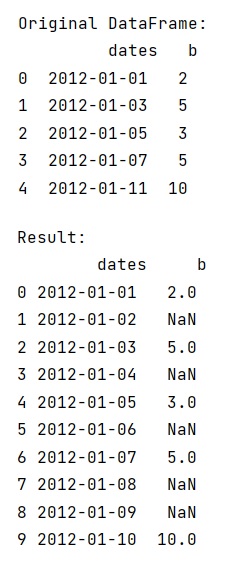Home »
Python »
Python Programs
Pandas: Extend Index of a DataFrame setting all columns for new rows to NaN?
Learn, how to extend index of a DataFrame and how to set all columns for new rows with NaN?
By Pranit Sharma Last updated : October 05, 2023
Pandas is a special tool that allows us to perform complex manipulations of data effectively and efficiently. Inside pandas, we mostly deal with a dataset in the form of DataFrame. DataFrames are 2-dimensional data structures in pandas. DataFrames consist of rows, columns, and data.
Problem statement
Suppose we are given a DataFrame which is a time-indexed DataFrame. It has a column that contains some integer values.
We need to extend this DataFrame so that it has one row for every day of a particular month (let us say December). We need to set the column values with NaN except where the values of the other columns are present.
Extending Index of a DataFrame setting all columns for new rows to NaN
For this purpose, we will first create a DataFrame with two columns, the first one would be the column of dates which we will set as the index and the other would be the column that contains some integer values.
We will then create a series of dates where we will define the start date and end date so that all the dates will become one of the rows of the DataFrame finally only the second column values which exist will appear and the rest of the values will be filled with NaN.
Let us understand with the help of an example,
Python program to extend Index of a DataFrame setting all columns for new rows to NaN
# Importing pandas package
import pandas as pd
# Importing numpy package
import numpy as np
# Import date
import datetime
# Creating a dictionary
d ={
'dates': pd.Series([datetime.date(2012, 1, 1), datetime.date(2012, 1, 3), datetime.date(2012,1,5),datetime.date(2012,1,7),datetime.date(2012,1,11)]),
'b' : pd.Series([2,5,3,5,10])
}
# Creating DataFrame
df = pd.DataFrame(d)
# Display dataframe
print('Original DataFrame:\n',df,'\n')
# Extending dataframe
range = pd.date_range(start=datetime.date(2012, 1, 1), end=datetime.date(2012, 1, 31), freq='D')
# Redefining indexes
res = df.reindex(range)
# Display Result
print("Result:\n",res)
Output
The output of the above program is:

Python Pandas Programs »
Advertisement
Advertisement